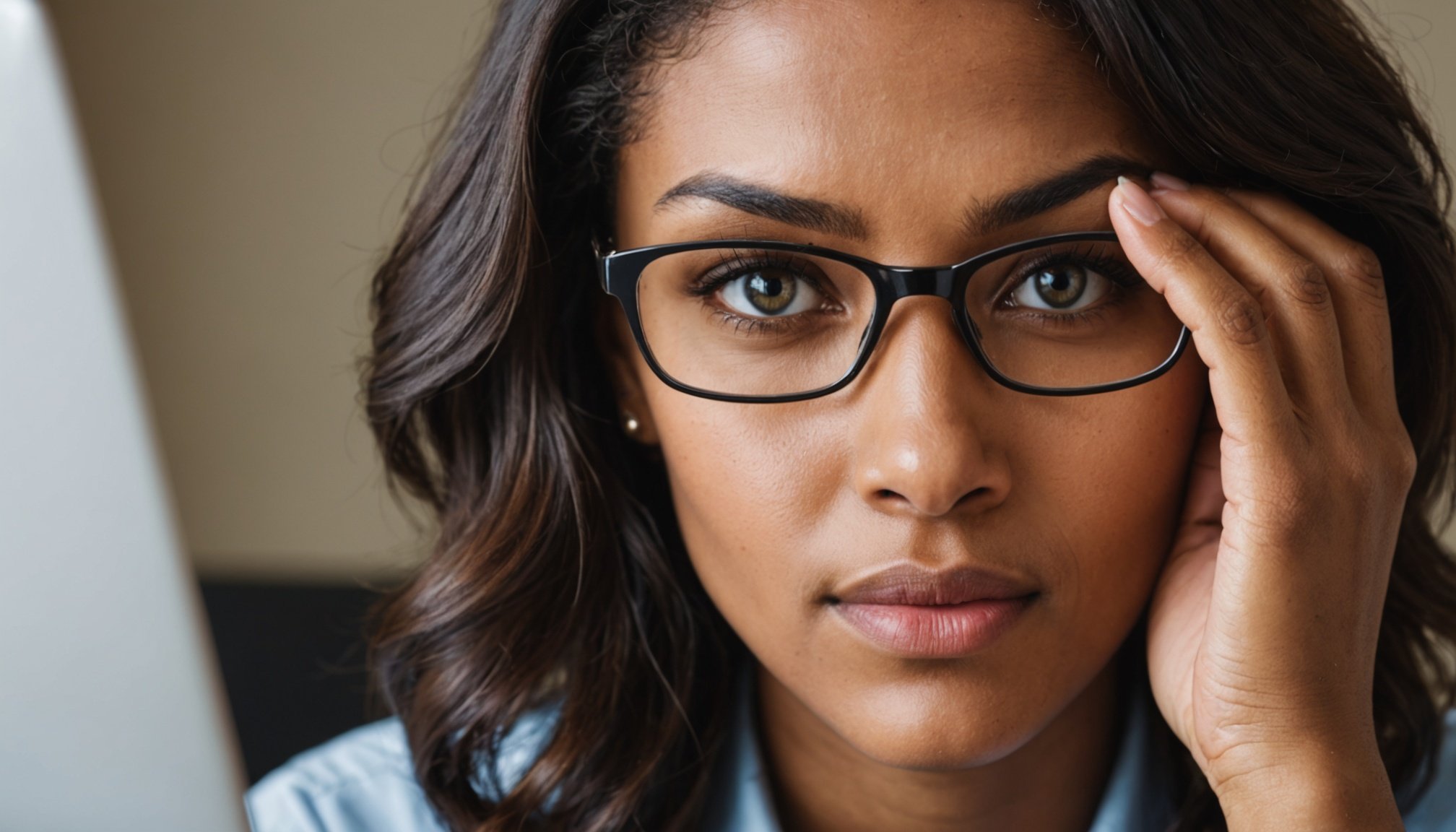Understanding Eye Strain in Women
Eye strain is a common issue, particularly among women who engage in prolonged computer use. Physically, women may experience differing levels of eye strain due to hormonal differences which can affect tear production and lead to dry eyes—a key contributor to discomfort during extended screen time. Prolonged computer use oftentimes results in symptoms like headaches, blurred vision, and irritation, which are notably prevalent among working women.
Statistics reveal that eye strain is increasingly prevalent in female professionals. This is supported by studies showing a significant percentage of women experiencing symptoms of eye strain in various work environments. Such symptoms include dryness, irritation, and fatigue, all exacerbated by the frequent and prolonged gaze at digital screens.
This might interest you : Unlock the Secret to Silky Lips: Craft Your Own Organic Lip Scrub at Home!
Additionally, research indicates that women are more likely to engage multitasking activities during screen use. This contributes to focusing strain which can affect visual health. Recognising the specific symptoms in women helps in understanding their unique experiences with prolonged computer use. These can include not only the conventional symptoms but also increased sensitivity to light and neck pain, due to varied working postures and environments.
Understanding these unique physiological and habitual factors is key to effectively addressing and managing eye strain in women, promoting a healthier digital lifestyle.
Have you seen this : Discover the Perfect Silk Scarf to Elevate Your Bohemian Summer Dress Style!
Ergonomic Adjustments for Comfort
Enhancing ergonomics at your workstation can significantly contribute to both comfort and health, particularly concerning your eyes. Proper workstation setup begins with the height and distance of your monitor. It’s essential to position the monitor so that your eyes are level with the top of the screen. This allows you to view the screen without tilting your head, which reduces strain on the neck and eyes. The optimal distance typically ranges from 20 to 30 inches from your eyes to the screen.
The adjustments of your chair also play a crucial part. A well-positioned chair ensures that your feet are flat on the floor, and your back is fully supported, promoting a healthy posture. Such positioning can surprisingly influence eye comfort, as a stable posture eliminates additional strain.
Moreover, ambient lighting is a critical consideration in managing eye strain. Excessive brightness or shadows can lead to discomfort and fatigue. A well-lit room with minimal glare on the monitor is ideal. Adjust window shades or position lamps to diffuse light evenly across your workspace. This setup not only supports productive work but also ensures long-term eye health, making ergonomics a worth-prioritizing aspect of daily routines.
Effective Eye Exercises
Physical strain is common for those spending long hours in front of screens. It’s essential to adopt eye exercises to ease discomfort and promote eye health.
The 20-20-20 Rule
One of the most effective relief techniques is the 20-20-20 Rule, designed to prevent eye strain. This involves taking a 20-second break to look at something 20 feet away every 20 minutes. The brief pause allows your eyes to shift focus and relax, reducing fatigue significantly. By integrating the 20-20-20 Rule into your work routine, you’ll likely notice an improvement in both comfort and productivity.
Eye Rolling and Blinking Exercises
Another beneficial exercise includes eye rolling and frequent blinking. Eye rolling can help lubricate the eyes and improve circulation, while blinking replenishes the eye’s tear film, which can dry out from prolonged screen use. To practice, roll your eyes in a circular motion and blink rapidly several times. These exercises are simple yet effective when repeated throughout your day.
Focusing Techniques
For further relief, focus-shift exercises can be invaluable. Alternate between viewing close-up objects and distant objects, maintaining each gaze for 15 seconds. Such activities help reduce stress on the eye muscles. Experts recommend incorporating these exercises one to three times an hour for maximum benefit, offering a practical strategy to preserve eye health over time.
Lifestyle Changes for Better Eye Health
Maintaining eye health is crucial, especially within the realm of women’s health, where certain lifestyle changes can make a significant difference. A key factor is ensuring adequate hydration and nutrition. Drinking enough water helps maintain the moisture of the eyes, preventing dryness. A diet rich in omega-3 fatty acids, vitamins C and E, and zinc supports overall eye wellness and helps combat age-related vision issues.
Another essential component is sleep hygiene. Consistent, quality sleep reduces eye fatigue and provides restorative rest crucial for maintaining optimal focus and comfort throughout the day. Establishing a regular sleep schedule and creating a soothing bedtime routine can significantly improve sleep quality.
In today’s digital age, managing screen time is paramount for preserving eye health. Excessive exposure leads to strain and discomfort, known as computer vision syndrome. To mitigate this, it’s advisable to take regular breaks using the 20-20-20 rule: every 20 minutes, shift your gaze to something 20 feet away for at least 20 seconds. This simple adjustment can alleviate stress on your eyes, ensuring you’re not overburdening them during prolonged screen use. Integrating these lifestyle changes can foster better eye health, allowing women to maintain sharp vision and overall well-being.
Utilizing Technology for Prevention
In today’s digital era, technology tools have become essential in maintaining eye health. Numerous apps are specifically designed for eye strain prevention, offering features that help reduce the impact of prolonged screen exposure.
Blue Light Filters and Their Effectiveness
Blue light filters are a popular means to mitigate digital eye strain. These solutions, available as apps or built-in features on devices, work by reducing the blue light emitted from screens, which is notorious for causing discomfort and disrupting sleep. Users report improved comfort after prolonged use, suggesting a significant positive impact on eye health.
Software Solutions to Monitor Screen Time
For individuals who spend extensive periods in front of screens, software solutions provide an effective way to monitor and manage screen time. By tracking usage patterns, these apps help users become aware of their habits and adjust accordingly to avoid or minimise eye strain.
Productivity Tools That Encourage Regular Breaks
Productivity tools can also play a crucial role in eye care by reminding users to take regular breaks. Apps like the Pomodoro timer encourage taking short, frequent breaks, reducing the risk of eye fatigue. For women, gender-specific resources are available, addressing different aspects of health and comfort.
Experts highlight the continual advancement of future technologies, focusing on enhancing eye protection. Testimonials often mention these tools’ practical benefits, indicating their utility in modern life.
Expert Advice and Testimonials
Gathering insights from women’s health professionals can significantly enhance our understanding of eye health. Interviews with optometrists specializing in women’s eye health reveal that regular eye exams are essential. These expert insights emphasize that consistent check-ups can detect early signs of eye strain and other issues, allowing for timely intervention.
Optometrists recommend scheduling professional eye exams at least once a year. They highlight that these examinations can uncover conditions that might otherwise go unnoticed. This proactive approach is not just about maintaining vision clarity but also about preventing more serious conditions. It’s crucial to consult specialists who understand the nuances specific to women’s eye health.
Moreover, testimonials from women who have successfully implemented eye strain reduction strategies illustrate their effectiveness. Many women report improved comfort and reduced strain by incorporating simple changes, such as the 20-20-20 rule or adjusting lighting and screen settings. These success stories not only encourage others to adopt similar habits but also reinforce the importance of professional guidance.
Ultimately, the combined wisdom of women’s health professionals and the positive experiences of those who’ve benefited from implementing specific strategies underscore the significance of prioritizing eye health through both daily practices and regular professional evaluations.











